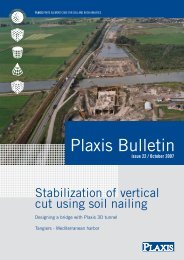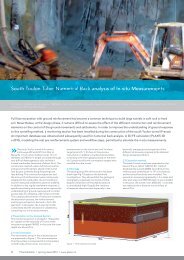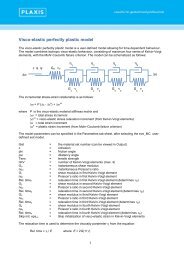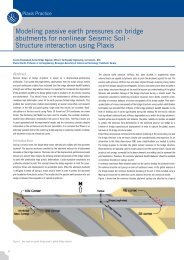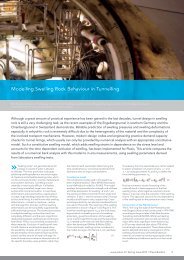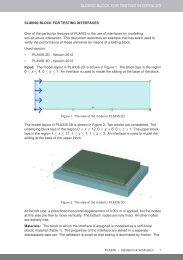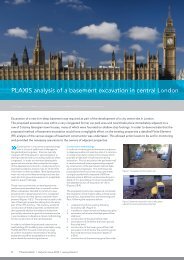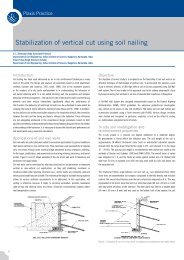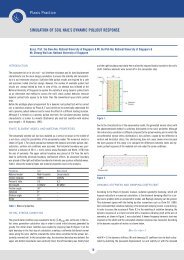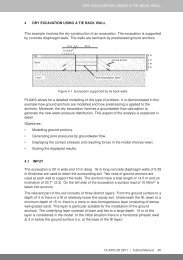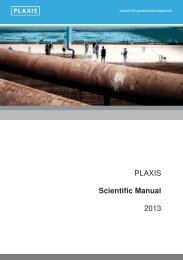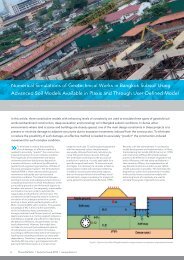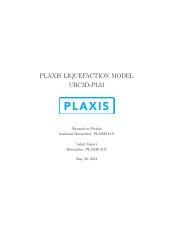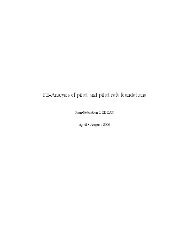Nicoll Highway Collapse: Evaluation of Geotechnical ... - Plaxis
Nicoll Highway Collapse: Evaluation of Geotechnical ... - Plaxis
Nicoll Highway Collapse: Evaluation of Geotechnical ... - Plaxis
Create successful ePaper yourself
Turn your PDF publications into a flip-book with our unique Google optimized e-Paper software.
ameters (c’, φ’) and undrained shear strength pr<strong>of</strong>iles, s u (z) (for all except the F1 unit) for all <strong>of</strong> the<br />
main soil units and JGP layers. Many <strong>of</strong> these parameters were based on prior experience (e.g., Bo et<br />
al., 2003; Tan et al., 2003; Chiam et al., 2003; Li & Wong, 2001). For example, the design elastic<br />
moduli, E [kPa] = 400s u and 2000N in the low permeability Kallang and Old Alluvium units, respectively.<br />
The critical parameters for design purposes are the undrained shear strength pr<strong>of</strong>ile <strong>of</strong> the Marine<br />
Clay, strength parameters and drainage conditions in the Old Alluvium. There are also significant<br />
uncertainties in evaluating the properties <strong>of</strong> the JGP rafts. Although UCS tests on core samples measure<br />
strengths much higher than those assumed in design, the mass performance <strong>of</strong> the raft depends on<br />
the continuity between individual jet grouted piles.<br />
2.1 Marine Clay<br />
There were three main sources <strong>of</strong> undrained shear strength data for the Marine Clays; 1) undrained<br />
triaxial shear tests (CIU type, with K 0 = 1.0), 2) in situ field vane shear tests, and 3) continuous piezocone<br />
penetration resistance data (these data were apparently not considered in GIM, 2001). Although<br />
the CIU tests were used to define the drained effective stress strength parameters (c’ = 0kPa and φ’ =<br />
22° and 24° for the Upper and Lower Marine Clay, respectively), they are not a reliable source <strong>of</strong> information<br />
on the in situ undrained strength ratio, s u /σ’ v (which is affected significantly by the in situ<br />
K 0 condition). There was a large scatter in the field vane data, s uFV , which included some very low<br />
measurements <strong>of</strong> undrained shear strengths in the LMC unit. The interpretation <strong>of</strong> these data is further<br />
complicated by the practice <strong>of</strong> selecting correction factors in estimating design strengths (i.e., the design<br />
strength, s u = µs uFV , where the correction factor µ[I P ] was first proposed by Bjerrum, 1973).<br />
Piezocone penetration records provide a more reliable source <strong>of</strong> information on the undrained shear<br />
strength pr<strong>of</strong>ile in the low permeability clay units. The undrained strength can be correlated to the net<br />
tip resistance, (q T -σ v0 ), through an empirical cone factor, N kT :<br />
s u = (q T – σ v0 )/N kT (1)<br />
where q T is the measured cone resistance (corrected to account for differential pore pressures acting<br />
around the surface <strong>of</strong> the conical tip), and σ v0 is the total overburden pressure.<br />
The cone factor is best estimated through empirical correlations with reference measurements <strong>of</strong><br />
undrained shear strength from (high quality) laboratory laboratory tests measured in different modes <strong>of</strong><br />
shearing (triaxial compression, triaxial extension and direct simple shear). Tan et al. (2003) proposed<br />
N kT = 12 for the Marine Clay based on correlations with laboratory tests at two other sites in Singapore,<br />
while the various experts contributing to the COI assumed N kT = 12 – 14. These values are well<br />
within the range <strong>of</strong> empirical correlations presented by Lunne et al. (1997). Figure 7 compares the<br />
undrained strength pr<strong>of</strong>iles interpreted from 4 piezocone tests in the M3 area assuming N kT = 14. The<br />
tests show very consistent agreement in both the Upper and Lower Marine Clay units, while AC-3<br />
gives substantially high shear strengths than the other three for the UMC layer.<br />
The undrained shear strength ratio <strong>of</strong> the normally consolidated Marine Clay is usually assumed to<br />
be; s u /σ’ v0 = 0.21 (for the direct simple shear mode <strong>of</strong> shearing; Tan et al., 2003). Figure 7 shows that<br />
this strength ratio is consistent with the interpreted piezocone strengths at elevations 86 - 94mRL and<br />
75 - 80mRL, based on the estimated pr<strong>of</strong>ile <strong>of</strong> the current vertical effective stress (Fig. 7b). However,<br />
the data also suggest that the Lower Marine Clay below 75mRL is weaker than this expected strength<br />
pr<strong>of</strong>ile. The interpreted strength at the base <strong>of</strong> the LMC unit (at 63mRL), s u = 47kPa, is more than<br />
10kPa less than the undrained shear strength expected for the normally consolidated clay. This behavior<br />
can be attributed to one or more <strong>of</strong> the following factors: i) the Lower Marine Clay should be<br />
described has a lower undrained strength ratio than the overlying units. There is no direct experimental<br />
basis for this assumption. ii) The Lower Marine Clay is underconsolidated locally (i.e., has not fully<br />
consolidated under the 5m fill placed in the 1970’s). This implies that the piezometric pressures in the<br />
Lower Marine Clay are higher than 103mRL and could explain the surface settlements shown in Figure<br />
6. It also implies that there is no seepage into the underlying Old Alluvium (i.e., there is one way<br />
upward drainage within the LMC). iii) Undrained shear strength in the LMC is underestimated using<br />
N kT =14. There is no direct basis for refining the selection <strong>of</strong> N kT , the current choice produces consistent<br />
interpretation <strong>of</strong> the design s u pr<strong>of</strong>ile above 75mRL. The GIM (2001) design table assumes that<br />
the Marine Clay is normally consolidated below a depth <strong>of</strong> 15m and hence, potentially overestimates<br />
the undrained shear strength by up to 10-15kPa. There were no reliable stress history data obtained<br />
from the pre- and post-tender site investigations. However, data from the post-collapse investigations<br />
(at boreholes outside the zone <strong>of</strong> the collapse), Fig. 7b, confirm that the Marine Clay is normally con-



